A Racial Introduction to Chile, Part II
Benjamin Villaroel, American Renaissance, September 5, 2018
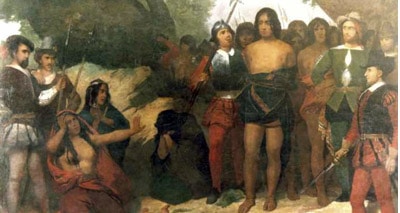
This is the second of a three-part series. Here is part one. Here is part three.
Unassimilable minorities
A small number of gypsies came with the waves of immigrants and settlers from Iberia, and the later waves of immigrants from Eastern Europe. Today their number is estimated at between 15,000 and 20,000. This is very small, to be sure, but just as Jews and East Asians do well wherever they are, gypsies do poorly and misbehave wherever they are, including Chile. Many American readers may be unfamiliar with gypsies, but they are poor, violent, exploit welfare systems and charities alike, and have a special affinity for petty theft, scams, and shockingly aggressive begging — perhaps better called “demanding.” For a more detailed account of their ancestry and behavior, I recommend reading this review by F. Roger Devlin of Jelena Čvorović’s The Roma: A Balkan Underclass. There are no data available about their behavior in Chile, but there is a nationwide understanding of what they are like, and I have just described it. Gypsy houses are easily identifiable by their shabby and filthy condition and garbage-strewn lawns. They are also easily identifiable by speech, since most still speak the Romani language among themselves.
Amerindians have been the most consequential source of racial strife in Chile — especially the Araucanos, which make up 80 percent of Chile’s 12 percent Amerindian population. Both historically and today, they have been concentrated in the middle-south of Chile:
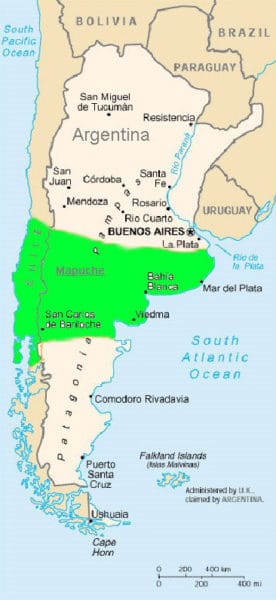
Before the arrival of Europeans, the Araucanos were the regional power of the Southern Cone, absorbing, conquering, and occasionally maintaining uneasy peace with the various smaller tribes in their midst. Importantly, in the late 15th century, they halted the Inca Empire’s impressive southward expansion at the Maule River, about a three-hour drive south of present-day Santiago. The clash between the two peoples that definitively ended serious Inca encroachment is said to have lasted three days and involved around 20,000 warriors on each side — an epic engagement for an isolated pocket of South American in the 1400s. However, due to overexpansion, the catastrophic Inca Civil War of the early 16th century, and the subsequent arrival of conquistadores at the heart of the Inca Empire, the Incas never firmly held what is now north-central Chile, and the Araucanos managed to expand northward before the Spanish reached them.
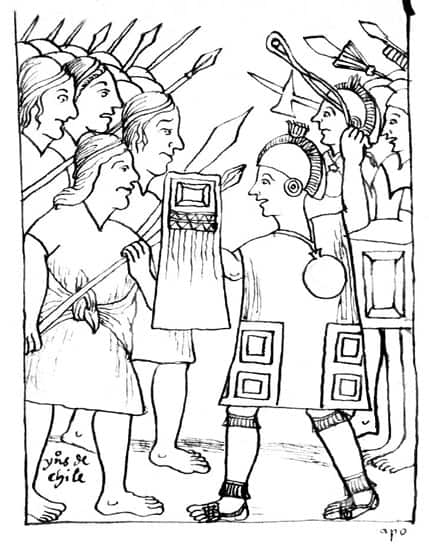
The Battle of Maule — Araucanos on the left, Incas on the right.
Latin America’s two largest and best known Amerindian civilizations, the Aztecs and the Incas, were both decisively defeated by the Spanish in the sixteenth century, (1519-1521 and 1532-1572, respectively), but the Araucanos held out until the late 19th century. This is in part for geographic reasons, which I will explain. When looking at a political map of South America, Chile’s borders seem silly and arbitrary — but nothing could be further from the truth. To its west is the Pacific Ocean. To its east, separating it from Argentina, are the Andes mountains. They are the longest mountain range on earth (that isn’t at the bottom of the ocean) — over 1,000 miles longer than the Rockies. The only mountain ranges with higher peaks are in the Himalayas — and the highest peak in the Andes is over 8,000 feet higher than the highest peak in the Rockies. There are also volcanoes sprinkled throughout the range. Even today, the vast majority of the Andes cannot be crossed with anything but specialized vehicles — and in some parts not even that will do. The border between Chile and Argentina is 3,200 miles long, but there are only 33 highway crossing points open to the public. The grand total of official crossings points is only 49. For comparison, the US-Mexican border, at 1,954 miles, is less than two-thirds as long, and has 48 official border crossings. The terrain of the Chilean-Argentine frontier is incredibly rough. Many of the passes are open only in the summer, and all of them close regularly but with little warning because of storms, snow, and small avalanches. At least one has a dedicated infirmary to handle the many people who get altitude sickness while passing through.
To the north of Chile is the 41,000-square-mile Atacama desert, the driest on the planet. On the whole, it averages 1.5 centimeters of rain a year. In its driest parts, annual rainfall is measured in milliliters, and generally ranges from 1 to 3, and there have been years of effectively zero rainfall. At its hottest on a summer day, temperatures reach 95° F. At its coldest during a winter night, temperatures drop to 24 °F. Its landscape is so barren and inhospitable that is often compared to Mars. NASA tests instruments bound for Mars in the Atacama desert. Therefore, reaching what is now Chile before the advent of modern technology was not easy, so Spanish colonization there was considerably slower than anywhere else in the New World.
Still, conflict between Europeans and Araucanos began almost immediately after the first Spanish conquistadores and explorers arrived. The battle of Reynogüelén in 1536 is widely considered the opening of the “Arauco War.” Though outnumbered by several thousand, the Spanish won, suffering only two deaths, largely because they had horses, iron armor, and iron weapons. Things did not always go so well for them.
There were four main reasons the Araucanos staved off domination for so long, all of them analogous to the Apaches in the United States, who also were not completely pacified until the final third of the 19th century:
- They were tough and able warriors — some argue they were even tougher than the ferocious Aztecs.
- Geography was on their side. Not only was their land hard for outsiders to navigate and master, it also was not obviously valuable or resource-rich, so there was less incentive to occupy it. Their land was not particularly close to major settler population centers.
- They obtained horses, and learned to ride them.
- They obtained firearms, and learned to use them.
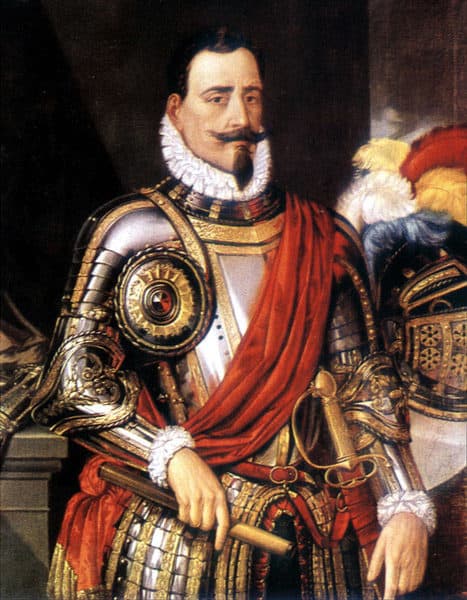
Pedro de Valdivia, the Francisco Pizarro of Chile.
This is what happened after the first few “introductory battles:”
Mid-sixteenth century: Pedro de Valdivia, who was what you could call a “Founding Conquistador” of Chile (as opposed to one of its 19th century “Founding Fathers”), finally secures the city of Santiago. He then pushes south and helps establish what is now the South’s most populous city: Concepción. Concepción is located at the juncture of the northern bank of the Bío Bío River, and the Pacific coast, and the Bío Bío River becomes the default border between the Spanish and the Araucanos.

The most well remembered Araucano toquis (“warrior chiefs”) are Caupolican and Lautaro. Today, both are revered in Chilean culture much like Geronimo and Sitting Bull in the United States.
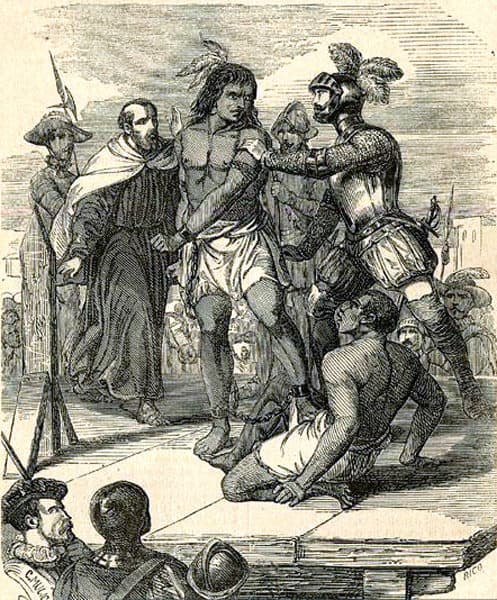
The death of Caupolican.
The book that effectively founded Chilean literature was the epic poem La Araucana by Alonso de Ercilla (first published in three volumes; 1569, 1578, and 1589), which recounts this period of the Arauco War, of which he was a veteran — with great respect for both sides. Don Quixote author Miguel Cervantes began his writing career only a few decades after Ercilla, and was deeply influenced by La Araucana, which even makes a cameo appearance in Quixote.
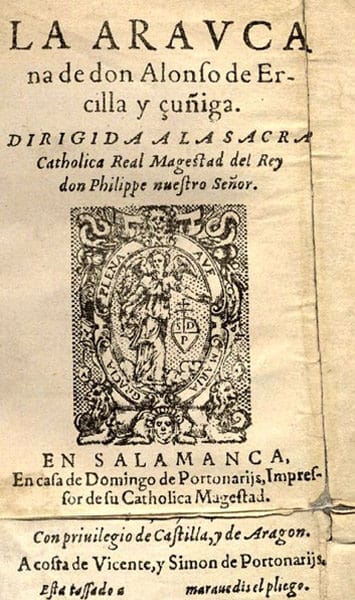
Second edition of the first volume (1574).
Late 16th century until the outbreak of the War for Independence in 1810: Though the Bío Bío river is supposed to be the border, it is always shifting. The Spanish periodically push south, and the Araucanos periodically push north and wipe out towns and outposts. The number of Spanish “campaigns” and Araucano “rebellions” between 1540 and 1810 is best counted by the dozens.
It is during this time that a handful of ethnographies are done of Chile. Aside from the obvious limits of collecting demographic data between the 1500s and the 1800s, there were also a number of border changes that make these figures uncertain. Also, in Latin America “mulatto” does not always mean “half white and half black,” but can also mean simply “half black,” or even “of some black ancestry.”
Renowned Chilean historian Sergio Villalobos, writing in the 1980s, estimated that in 1600, the racial breakdown of Chile was:
| Hispanic Creoles | Mestizos | Blacks and mixed blacks | Amerindians | Total |
| 7,525 | 20,000 | 3,000 | 160,000 | 190,525 |
Writing in the 1950s, another historian, Ángel Rosenblat, gave estimates for 1570 and 1650:
| Population | 1570 | 1650 |
| Amerindian | 600,000 | 520,000 |
| Mestizo | 10,000 | 8,000 |
| White | 10,000 | 15,000 |
| Black | 5,000 | |
| Mulatto | 2,000 | |
| Total | 625,000 | 545,000 |
Jose Gonzalez Rivera, a Jesuit missionary at the time, estimated Chile’s population in 1669 to be:
| Spaniards | White mestizos | Blacks and colored mestizos | Amerindians | Total |
| 25,000 | 45,000 | 20,000 | 500,000 | 590,000 |
Rolando Mellafe, another Chilean historian, writing in the 1960s, broke down Chile’s historical demographics this way:
| Year | Whites | Mestizos | Blacks and Mulattos | Amerindians (pacified) | Amerindians (savage) | Total population |
| 1540 | 154 | 0 | 10 | 0 | 1,000,000 | 1,000,164 |
| 1570 | 7,000 | 10,000 | 7,000 | 450,000 | 150,000 | 624,000 |
| 1590 | 9,000 | 17,000 | 16,000 | 420,000 | 120,000 | 582,000 |
| 1600 | 10,000 | 20,000 | 19,000 | 230,000 | 270,000 | 549,000 |
| 1620 | 15,000 | 40,000 | 22,000 | 230,000 | 250,000 | 557,000 |
In the early historical period, there were some blacks, though not many. They were slaves brought in from Peru and Bolivia by a handful of military men and large landowners. Black slavery in Chile, however, never went very far. Before the modern era, travel to Chile was difficult, so settlers brought only what was necessary — and it did not make sense to bring in black slaves when defeated Amerindian populations could be enslaved. Moreover, Chile’s economy has never been based on massive agriculture as in the American South or the more tropical parts of Latin America, further decreasing any incentive to bring in slaves. Although slaves have been used in large mines, the mines in northern Chile were not established until well after independence and abolition.
The small number of blacks in Chile interbred and ceased to be a distinct racial category by the 18th century — at the latest. Note that in Rosenblat’s demographic estimates, the number of pure blacks in 1570 is put at 5,000, but by 1650 no pure blacks are listed — and only 2,000 mulattos. By 1669, Gonzalez Rivera did not think any exclusively “black” category was necessary, and simply lumped people with black blood in with darker mestizos. Mellacafe’s numbers for blacks and mulattos are high, and I suspect he used a “one drop” rule, inflating the number. Compare his numbers with those of Gonzalez Rivera, and it seems likely that many of Mellacafe’s “mulattos” are mestizos with a black great-grandparent. In any case, by the 1700s, Chile was considered to have no blacks, with a vague understanding that the underclass had some small amount of black blood. Though never practiced widely, slavery was abolished with the end of Spain’s dominion. The phenomena of a black substrata of Chilean society is an entirely new — and self-inflicted — misfortune.
1810-1825: This was the period of Chile’s War for Independence. In yet another curious parallel to the United States, Chile’s Amerindians sided mostly with the European colonial power, not the independence-seeking settlers. However, there was minimal coordination between the Spanish royalists and the Araucanos, so during this time Chilean nationalists were fighting two wars at once, one against the Spanish crown and another a suddenly intensified Arauco War — so intense it was dubbed the “War to the death.” When Chile finally achieved independence, it almost immediately brokered a peace with the Araucanos. The agreed upon borders of the Arauco nation was the Toltén River (south) and the Bío Bío River (north).
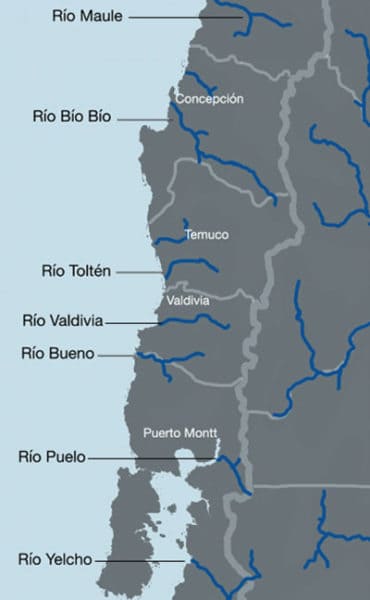
1825-1861: This was perhaps the lowest ebb of conflict between Europeans and Araucanos before the modern era. There were skirmishes and violence, but on the whole, the new nation of Chile was focused on its own domestic growing pains, and made no serious attempts at territorial encroachment. The Araucanos, perhaps relieved at the first prospect of a lasting peace in three centuries, made no attempt to expand their borders.
1861-1883: This period is known alternatively as “the occupation of Araucania” and “the pacification of Araucania.” Just as how the United States government focused fully on westward expansion after the resolution of its Civil War, Chile, once past the internal problems of fledgling countries, set its eyes south. After 22 years of concentrated invasions and occupations, Araucania was fully absorbed into the Chilean polity. The country of Araucania became the region of Araucania, subordinate to the Chilean federal government in Santiago. Two tangential points worth noting: 1) Argentina had a sizable independent population of Araucanos as well. Imitating Chile, they set about absorbing it in the late 1870s — which they call “the conquest of the desert.” The Argentine strategy, however, was considerably less assimilationist and more eliminationist than Chile’s. Argentina has had a much larger population than Chile (right now Argentina has about 44.5 million inhabitants to Chile’s 17.5), but today Chile’s Amerindian population is about twelve percent of the whole, with around 1.7 million Araucanos. Meanwhile, Argentina’s Amerindian population is about 2.3 percent of the whole, with around 205,000 Araucanos. 2) Many argue that the initial success of the pacification of Araucania helped convince Chile that it could defeat Bolivia and Peru in a full scale war, which did actually transpire (1879-1884). To one degree or another, this is true. The result, from a racial bird’s eye view, was a dramatic expansion of whites, at the expense of Amerindians and mestizos, both north and south over the course of the nineteenth century — just as with America’s westward expansion.
1883-present: Again, much as in the United States, from the late 19th century up until the present, white-Amerindian conflict has been confined to low-level street crime, periodic spats of terrorist attacks by Amerindian nationalists, and the occasional fatal shootings of nationalists by police. The most common kind of terrorist strike is burning trucks and machinery owned by large foresting and agricultural corporations operating in the Araucania. Drivers and workers are always given enough time to flee before the fires are started. Less frequently, empty (but not abandoned) Christian churches are burned down. Activists sometimes burn down the houses of wealthy whites in the area. Some Araucanos talk tough, but deaths are uncommon. Though there is one very important exception to this that is still talked about. In a headline that could have come from a rural South African newspaper, in January of 2013, a group of masked assailants surrounded and set ablaze a wealthy rural estate in the Araucania owned by elderly whites who had longstanding disputes with local Araucanos about their property line. Shortly before they were incinerated, the husband managed to exchange fire with the attackers, and the wife managed to make one desperate call to the police. The audio of that call is now available online, and is quite difficult to listen to. She clearly knows that she and her husband will be dead in a few minutes. The only assailant who was caught was the one the husband managed to shoot.
Araucania has the most Araucanos of any region (ranging from a fourth to a third of the population), and is also the poorest — this is not a coincidence.
Other Amerindian peoples in Chile are present in much smaller numbers:
1) The Rapa Nui
This is the tribe native to Easter Island, which Chile annexed bloodlessly in 1888, and who were given full citizenship only in 1966. At the time of annexation, the Rapa Nui were on the verge of extinction, with a total population of 111. This was due to a convergence of catastrophes, best documented by Jared Diamond. First, the Rapa Nui did much to deplete the island’s natural resources and destroy its delicate ecology. Then there was a series of violent power struggles, the details of which are not well known. Then Peruvian slave traders kidnapped about half the population over the course of less than a year. When the slave traders were forced by the Peruvian government to return those that could be rounded up (slavery was illegal in Peru by the 1860s), smallpox was introduced to the island. Whalers introduced tuberculosis to the island around the same time.
Today, with a population near 10,000 (about 45 percent of the population of the island), they are doing much better. Like the Araucanos, they occasionally commit acts of showy terrorism, mostly brief seizures of buildings they claim should be theirs. Each time this happens, police storm the building, use pellet guns to subdue the occupiers, and make a few arrests. No deaths have ever come of this.
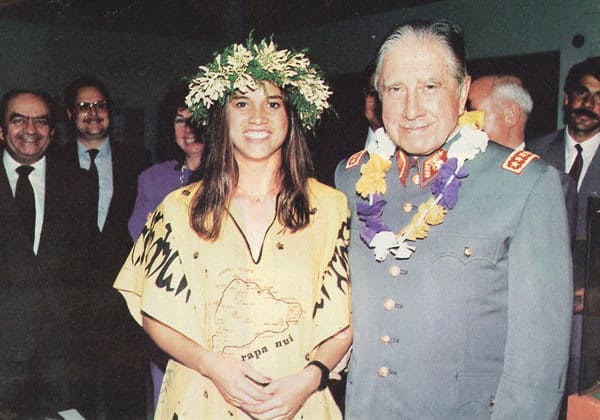
General Pinochet with a Rapa Nui woman.
On the whole, Chileans think of Easter Island much the way Americans think of Hawaii: a faraway place for vacationers, largely separate from the continental culture, economy, and politics. To put it more bluntly: Nobody really cares about it, and it is not obvious why they should.
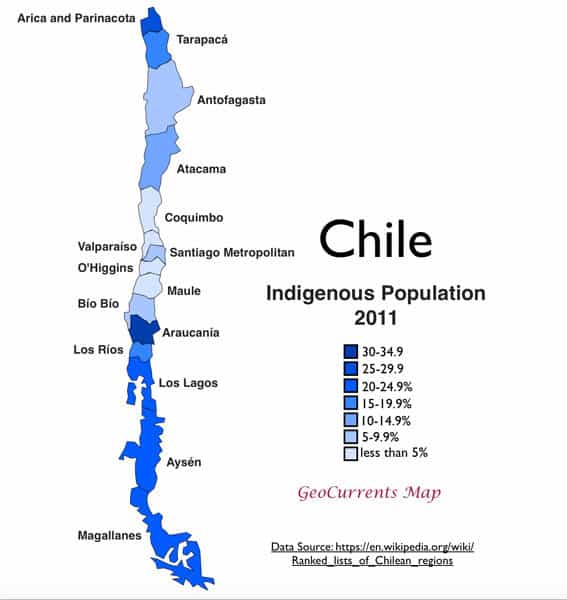
Demographic map of Amerindian populations in Chile, by region (not tribe-specific)
2) Tiny tribes scattered throughout the deep south, such as the Alacalufe and the Yaghan.
The largest of these groups have populations in the low thousands, and they are not going to last much longer. Plenty of other small tribes from the deep south have gone extinct, such as the Manek’enk and the Selk’nam — the last of whom died in 1974. Throughout the world, though mainly in the global south, linguists are recording the extinction of the world’s languages (about 400 in the 20th century) and predicting how many will be gone by the end of this century: between 3,250 and 5,850. Sometimes, the death of a language means a small population has simply integrated and intermarried, but it is also far from uncommon that the last native speaker finally died.
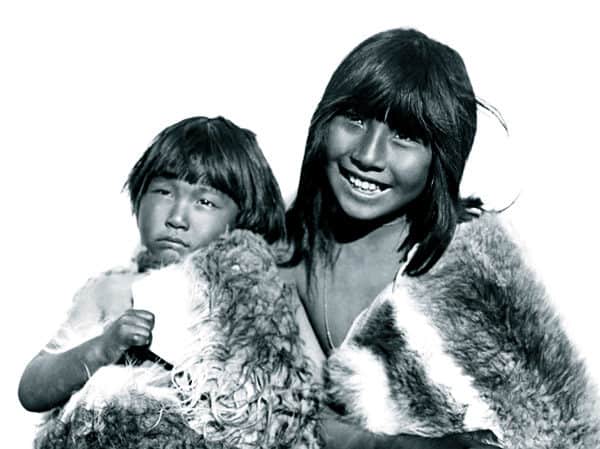
Selk’nam children in 1898.
The Amerindians left in Chile’s deep south have survived because they are in the very sparsely populated and very inhospitable southernmost lands. The above demographic map of Amerindians in Chile is somewhat deceptive: it shows a large Amerindian presence in the deep south, but this is only because the area is so sparsely populated. About three quarters of Chile’s population lives in or between the cities of La Serena and Concepción — basically the middle third of the country. The total population of the bottom four regions is only 1,471,295 — about 8.5 percent of the national population. In another century or so, few of these deep-south Amerindians will be left.
3) The Diaguitas
The Diaguitas were present in Chile’s northernmost pre-War of the Pacific region, and are the third largest Amerindian group in the country. Diaguitas are like hippies: they are very laid back and do not do much besides play the drums and make mediocre jewelry and ceramics.
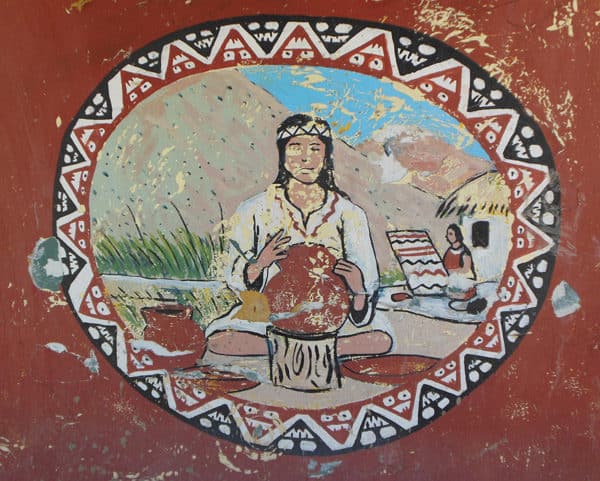
4) Northern tribes that were absorbed after the War of the Pacific
These include the Aymara (the second largest Amerindian tribe in Chile), Quechua, Atacama, Qulla, and Inca. They do not vary much between themselves, and are similar to Bolivians or Peruvians. Bolivia’s current socialist president Evo Morales, for example, is Aymara.
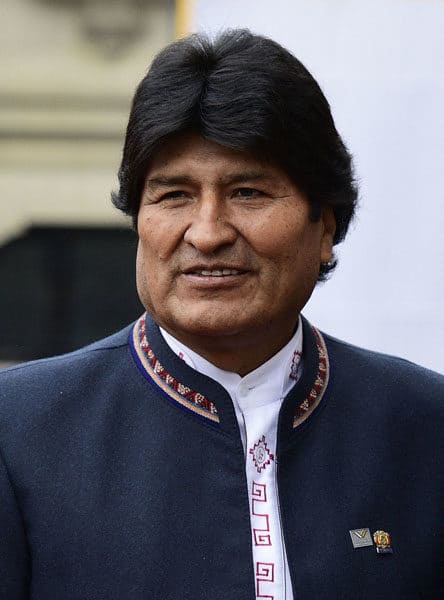
Evo Morales
| Amerindians in Chile as of 2017 | ||
| Amerindian Tribe | Total Population | Percent of Total Population of Amerindians |
| Araucano | 1,745,147 | 79.8 |
| Aymara | 156,754 | 7.2 |
| Diaguita | 88,474 | 4.1 |
| Quechua | 33,868 | 1.6 |
| Atacama | 30,369 | 1.4 |
| Qulla | 20,744 | 0.9 |
| Rapa Nui | 9,399 | 0.4 |
| Alacalufe | 3,448 | 0.1 |
| Yaghan | 1,600 | 0.1 |
| Other | 95,989 | 4.4 |
| Total | 2,185,792 | 100.0 |
(Source for this table is page 16 of the 2017 Chilean census, here. However, the table itself is from the Spanish-language Wikipedia page for Chile, here.)
Aside from the Araucania, Chile’s northern third has always been the least European part of the country — and strikingly so, since the northern Amerindians are much darker than are Araucanos and the other southern tribes. The whites, castizos, and mestizos of northern Chile are all visibly darker than the people of the same racial categories in the much whiter south. This difference is accentuated by the fact that Middle Eastern peoples settled mainly in the north, while the Germans and Croatians settled mainly in the south.
At the end of the Mexican-American War, there was considerable debate in America over how much of Mexico to annex. The southern statesman John C. Calhoun wisely warned against those who wanted the entire of the country:
… we have never dreamt of incorporating into our Union any but the Caucasian race — the free white race. To incorporate Mexico, would be the very first instance of the kind of incorporating an Indian race; for more than half of the Mexicans are Indians, and the other is composed chiefly of mixed tribes. I protest against such a union as that! Ours, sir, is the Government of a white race. The greatest misfortunes of Spanish America are to be traced to the fatal error of placing these colored races on an equality with the white race. . . .
Sir, it is a remarkable fact, that in the whole history of man, as far as my knowledge extends, there is no instance whatever of any civilized colored races being found equal to the establishment of free popular government, although by far the largest portion of the human family is composed of these races. . . .
Are you, any of you, willing that your States should be governed by these twenty-odd Mexican States, with a population of about only one million of your blood, and two or three millions of mixed blood . . . all the rest pure Indians, . . . not as good as Cherokees or Choctaws? [who were both, in the frankness of the era, considered to be two of the “Five Civilized Tribes”]
Calhoun’s fears were, to a large extent, realized in Chile after the War of the Pacific. With the new land came new, less white Amerindian people, probably not as advanced as the Amerindians already in the country. While the country was certainly not overwhelmed by Amerindians and mestizos, their disproportionate presence in the north has always been a source of low-level racial tension and strife. The northern quarter of the country is entirely defined by the immense mines there. The laborers and roughnecks of these mines have always been distinctly swarthy, while the owners, managers, and engineers have always been largely of the old Iberian aristocracy and enterprising Germans and Croatians (when not foreign, and then predominantly American and British). For example, the copper mining company, Antofagasta PLC, is run by the Luksić family, of Croatian heritage. When Andrónico Luksić Abaroa died in 2005, Forbes put his net worth at 4.2 billion dollars, making him the richest man in Chile and the 132nd richest man in the world. At the time of this writing, his widow Iris Fontbona is estimated by Forbes to be worth 16.4 billion dollars, making her the richest Chilean, and the 80th richest person in the world. Chile punches well above its weight when it comes to billionaires, with a current total of 11. All of them are very evidently of majority European, Jewish, and/or Middle Eastern heritage. Six made their fortunes predominantly in the fields of mining, forestry, and/or paper. Whereas the first industry is controlled by whites and runs on northern Amerindian and mestizo labor, the last two are controlled by whites and run on Araucano labor.

Iris Fontbona appearing on Teleton.
As I have noted a few times already, in a strange parallel with the United States, from the late 19th century into the early 20th century, Chile was rocked by a surge of labor-related disruptions and violence. Most were when miners went on strike to protest intolerable working conditions and soldiers were brought in to keep order. The Chilean Army is very Prussian — to this day they “goose-step” — and the national police force is very Italian — they are called carabineros, like the Italian carabinieri, not policia. The officer class of the armed forces comes largely from the longstanding Iberian aristocracy. Moreover, military men at the time were often veterans of the War of the Pacific, or the sons of veterans. Antagonism between the military and the Amerindian miners was enormous, and the confrontations between the two groups would often escalate quickly and end with hundreds, sometimes even thousands, of casualties.
Most Deadly Miner-Military Clashes
| Name | Date | Location | Estimated Dead |
| Santa María School massacre | December 21, 1907 | Iquique, Tarapacá | 2,300 |
| La Coruña massacre | June 5, 1925 | La Coruña, Tarapacá | 2,000 |
| Columbus Plaza massacre | February 6, 1906 | Antofagasta, Antofagasta | 175 |
| Marusia massacre | March, 1925 | Marusia, Tarapacá | 500 |
Tensions between white and non-white workers got violent as well. In the early 20th century white workers banded together informally in what were called “anti-Peruvian leagues,” that engaged in street and workplace violence and intimidation against darker-skinned rivals.
This contributed to the rise of Marxism in Chile. Luis Emilio Recabarren, a Basque from Valparaiso, turned to radical Leftism after seeing the plight of the miners during a trip to the north. He went on to found what became the Chilean Communist Party — which unfortunately has not been a powerless fringe group like its various American analogues — and became an influential congressman representing the mining city of Antofagasta. Recabarren was an intelligent, honest, and empathetic man who genuinely wanted to improve the plight of the poor. Not long after the Bolshevik takeover of the USSR, he excitedly toured the new nation. After his return, he had a crisis of conscience and killed himself.
The spoils of the War of the Pacific, then, have been a double-edged sword. The expanded coastline, increased and varied agricultural lands, and most especially, the mines, have greatly increased Chilean prosperity. Copper alone oscillates between being 30 and 60 percent of all exports. Chilean rhenium reserves are the largest on the planet. The lithium and iodine in the north have certainly benefitted the economy. However, with this land came a permanent demographic problem that has weakened the national gene pool and fueled violence, stratification, and political radicalism.















